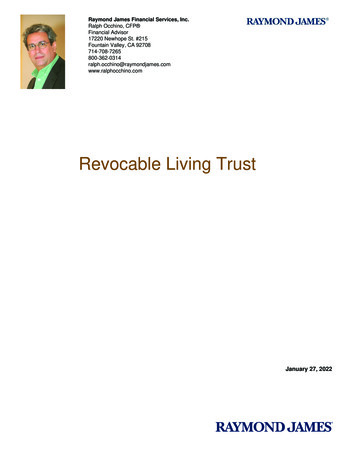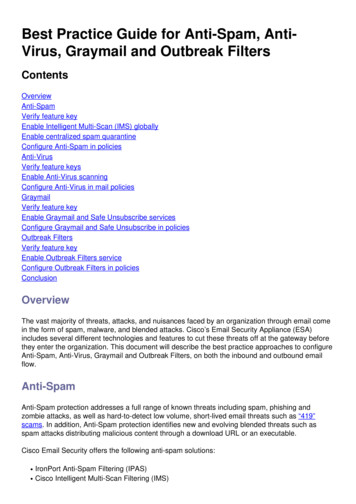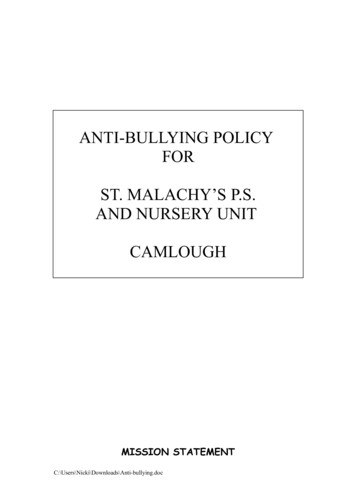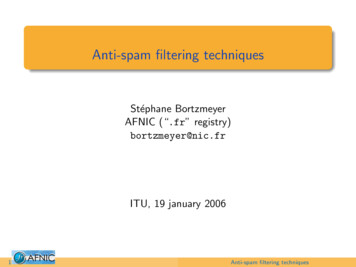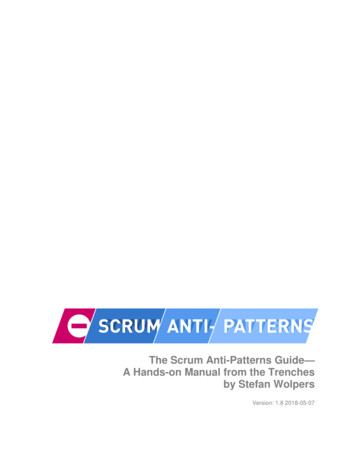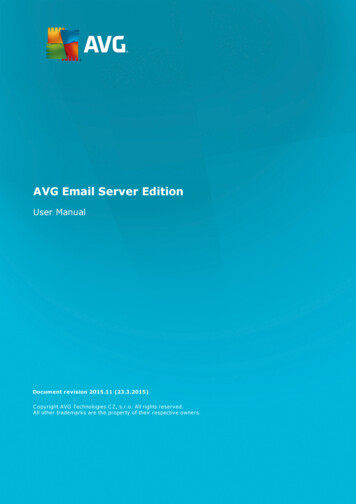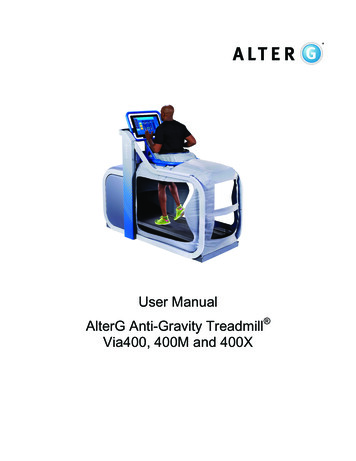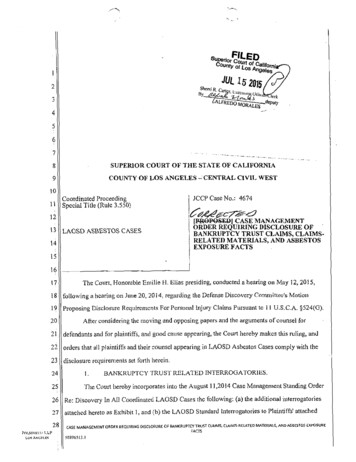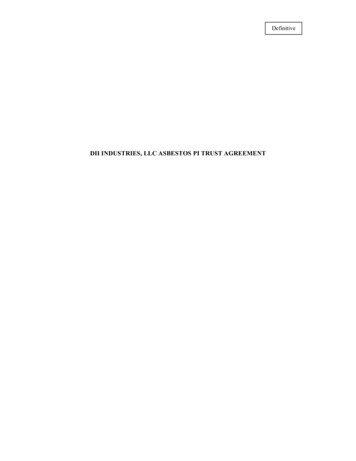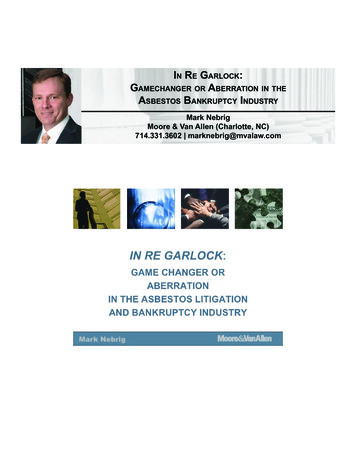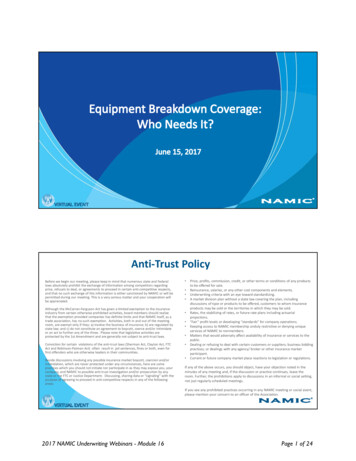
Transcription
Anti‐Trust PolicyBefore we begin our meeting, please keep in mind that numerous state and Federallaws absolutely prohibit the exchange of information among competitors regardingprice, refusals to deal, or agreements to proceed in certain anti‐competitive respects,and that no such exchange of this information is either sanctioned by NAMIC or will bepermitted during our meeting. This is a very serious matter and your cooperation willbe appreciated.Although the McCarran‐Ferguson Act has given a limited exemption to the insuranceindustry from certain otherwise prohibited activities, board members should realizethat the exemption provided companies has definite limits and that NAMIC itself, as atrade association, has no such exemption. Activities, both in and out of the meetingroom, are exempt only if they: a) involve the business of insurance; b) are regulated bystate law; and c) do not constitute an agreement to boycott, coerce and/or intimidateor an act to further any of the three. Please note that legislative activities areprotected by the 1st Amendment and are generally not subject to anti‐trust laws.Conviction for certain violations of the anti‐trust laws (Sherman Act, Clayton Act, FTCAct and Robinson‐Patman Act) often result in jail sentences, fines or both, even forfirst offenders who are otherwise leaders in their communities.Beside discussions involving any possible insurance market boycott, coercion and/orintimidation, which are never protected under any circumstances, here are somepractices which you should not initiate nor participate in as they may expose you, yourcompany, and NAMIC to possible anti‐trust investigation and/or prosecution by anystate or the FTC or Justice Department. Discussing, sharing data or “signaling” with thepurpose of agreeing to proceed in anti‐competitive respects in any of the followingareas: Price, profits, commission, credit, or other terms or conditions of any productsto be offered for sale.Reinsurance, salaries, or any other cost components and elements.Underwriting criteria with an eye toward standardizing.A market division plan without a state law covering the plan, includingdiscussions of type or products to be offered, customers to whom insuranceproducts may be sold or the territories in which they may be sold.Rates, the stabilizing of rates, or future rate plans including actuarialprojections.“Fair” profit levels or developing “standards” for company operations.Keeping access to NAMIC membership unduly restrictive or denying uniqueservices of NAMIC to nonmembers.Matters that would adversely affect availability of insurance or services to thepublic.Dealing or refusing to deal with certain customers or suppliers; business biddingpractices; or dealings with any agency/ broker or other insurance marketparticipant.Current or future company market place reactions to legislation or regulations.If any of the above occurs, you should object, have your objection noted in theminutes of any meeting and, if the discussion or practice continues, leave theroom. Further, the prohibitions apply to discussions in an informal or social setting,not just regularly scheduled meetings.If you see any prohibited practices occurring in any NAMIC meeting or social event,please mention your concern to an officer of the Association.2017 NAMIC Underwriting Webinars - Module 16Page 1 of 24
Asking QuestionsThanks to our sponsors e2Value can assist you with all of your Insurance-to-Value (ITV)and collateral value monitoring needs.2017 NAMIC Underwriting Webinars - Module 16Page 2 of 24
Thank you to our sponsors NAS is a leader in cyber liability insurance solutions for mutual insurancecompanies, providing turnkey insurance and breach response services for thecarrier’s policyholders.Craig Andrews, CPCU ARM AU‐M ARe AIC AMIM ASLI AAIAndrews Risk Advisory, LLCDefiance, om2017 NAMIC Underwriting Webinars - Module 16Page 3 of 24
Before We Begin Today’s webinar focuses on commercial property insurance issuesand is principally designed for a commercial underwriting audience.However, farm insurance underwriters may find certain aspects oftoday’s discussion relevant, and it should also have value forpersonal insurance underwriters who aspire to eventually transitioninto commercial insurance underwriting.Today’s Learning Objectives To identify common types of equipment found inbusiness operations today which are particularlyvulnerable to Causes of Loss excluded or limited instandard ISO Commercial Property Cause of Loss Forms To understand how exclusions and limitations in ISOCauses of Loss Forms can be overcome with EquipmentBreakdown Coverage To demonstrate why the obsolete term “Boiler and Machinery”insurance has no place in an underwriter’s vocabulary2017 NAMIC Underwriting Webinars - Module 16Page 4 of 24
Let’s begin by thinking about equipmentowned and used by businesses todayThis equipment generally falls into seven distinct andseparate categoriesKey Types Of Equipment Owned By Businesses#1: Electrical Equipment Power transformers Electric motors Distribution panels Cables Switchboard Circuit breakers Bus ducts2017 NAMIC Underwriting Webinars - Module 16Page 5 of 24
Key Types Of Equipment Owned By Businesses#2: Air Conditioning and RefrigerationEquipment Air conditioning motors Refrigeration motors Air conditioning and refrigeration system compressors Fans Switchboards Coils Piping VesselsKey Types Of Equipment Owned By Businesses#3: Boilers and Pressure Vessels Heating boilers Process boilers Pressure vessels Cookers Sterilizers Vulcanizers2017 NAMIC Underwriting Webinars - Module 16Page 6 of 24
Key Types Of Equipment Owned By Businesses#4: Computers and Communication Equipment Computing equipment (all types and sizes)– Including printing/copying/fax equipment Communication equipment––––Multi-line telephone systemsTelevision and satellite systemsRetail point of sale systemsSecurity and fire alarm systems Environmental control Diagnostic equipmentKey Types Of Equipment Owned By Businesses#5: Mechanical Equipment Pumps Fans Blowers Engines Commercial laundry equipment Turbines Air compressors2017 NAMIC Underwriting Webinars - Module 16Page 7 of 24
Key Types Of Equipment Owned By Businesses#6: Renewable/Alternative EnergyEquipment Solar (photovoltaic) panels and relatedequipment Wind turbines Geothermal pumpsKey Types Of Equipment Owned By Businesses#7: Production Machinery andEquipment Machining tools Food processing equipment CNC (Computerized Numerical Control)equipment Robots, robotic tools and related equipment2017 NAMIC Underwriting Webinars - Module 16Page 8 of 24
Polling Time!Quick Question # 1:Which equipment listed below is not included in the airconditioning and refrigerating equipment category? (Choosejust one response)A. Cooling system compressorsB. FansC. Steam boilersD. Switchboards2017 NAMIC Underwriting Webinars - Module 16Page 9 of 24
Let’s review how the most-used ISOCommercial Property Causes of Loss formcovers damage to these seven different typesof equipmentCP 10 30 10 12 Causes Of Loss – Special Form The most commonly‐used of the three ISO Commercial PropertyCause of Loss forms today The broadest of the three ISO Commercial Property Cause of Lossforms The CP 10 30 has a very broad initial Insuring Agreement:A. Covered Causes Of LossWhen Special is shown in the Declarations, Covered Causes of Lossmeans direct physical loss unless the loss is excluded or limited in thispolicy.But what about those exclusions and limitations?2017 NAMIC Underwriting Webinars - Module 16Page 10 of 24
CP 10 30 10 12 Exclusions2. We will not pay for loss or damage caused by or resulting from any of thefollowing:a.Artificially generated electrical, magnetic or electromagnetic energy that damages,disturbs or otherwise interferes with any:1) Electrical or electronic wire, device, appliance, system or network; or2) Device, appliance, system or network utilizing cellular or satellite technology.For the purposes of this exclusion, electrical, magnetic or electromagnetic energy includesbut is not limited to:a. Electrical current, including arcing;b. Electrical charge produced or conducted by a magnetic or electromagnetic field;c. Pulse of electromagnetic energy; ord. Electromagnetic waves or microwaves.But, if fire results, we will pay for the loss or damaged caused by that fireEquipment particularly vulnerable to damageexcluded by CP 10 30 Exclusion 2.a. Electrical equipment Air conditioning and refrigeration equipment Computers and communication equipment Mechanical equipment Renewal/alternative energy equipment Production machinery and equipment2017 NAMIC Underwriting Webinars - Module 16Page 11 of 24
Equipment vulnerable to damage excluded byCP 10 30 Exclusion 2.a.Consider potential damage to thisequipment caused by: Power surges Electric arcing Electric shorts caused by animals, vermin and reptiles Overheated electric distribution panelsTo cure the gap, add Equipment Breakdown Typical Equipment Breakdown Coverage Insuring Agreement:– We will pay for direct physical damage to Covered Property that is the direct result of an“accident” . Typical Equipment Breakdown Coverage definition of “accident”:– “accident” means a fortuitous event that causes direct physical damage to “coveredequipment”. The event must be one of the following b. Artificially generated electrical current, including electric arcing, that disturbs electricaldevices, appliances or wires Typical Equipment Breakdown Coverage definition of “coveredequipment”:– “covered equipment” means, unless otherwise specified in a Schedule, Covered Property (a)That generates, transmits or utilizes energy2017 NAMIC Underwriting Webinars - Module 16Page 12 of 24
Another CP 10 30 10 12 Exclusion .2. We will not pay for loss or damage caused by or resulting from any ofthe following: (d)6)Mechanical breakdown, including rupture or bursting caused by centrifugalforce. But if mechanical breakdown results in an elevator collision, we will payfor the loss or damage caused by that elevator collision.Equipment vulnerable to damage excluded byCP 10 30 Exclusion 2.d.(6) Electrical equipment Air conditioning and refrigeration equipment Boilers and pressure vessels Computers and communication equipment Mechanical equipment Renewal/alternative energy equipment Production machinery and equipment2017 NAMIC Underwriting Webinars - Module 16Page 13 of 24
To cure the gap, add Equipment Breakdown Typical Equipment Breakdown Coverage Insuring Agreement:– We will pay for direct physical damage to Covered Property that is the direct result of an“accident” . Typical Equipment Breakdown Coverage definition of “accident”:– “accident” means a fortuitous event that causes direct physical damage to “coveredequipment”. The event must be one of the following a. Mechanical breakdown, including rupture or bursting caused by centrifugal force. Typical Equipment Breakdown definition of “covered equipment”:– “covered equipment” means, unless otherwise specified in a Schedule, Covered Property (a)That generates, transmits or utilizes energy; or, (2) Which, during normal usage, operatesunder vacuum or pressure, other than the weight of its contents.Yet another CP 10 30 10 12 Exclusion 2. We will not pay for loss or damage caused by or resulting from any ofthe following:e.Explosion of steam boilers, steam pipes, steam engines or steam turbinesowned or leased by you, or operated under your control. But if explosion ofsteam boilers, steam pipes, steam engines or steam turbines results in fire orcombustion explosion, we will pay for loss or damage caused by that fire orcombustion explosion damage. We will also pay for loss or damage caused by orresulting from the explosion of gases or fuel within the furnace or any fired vesselor within the flues or passages through which the gases of combustion pass.2017 NAMIC Underwriting Webinars - Module 16Page 14 of 24
Equipment vulnerable to damage excluded byCP 10 30 Exclusion 2.e. Steam boilers Steam pipes Steam engines Steam turbinesTo cure the gap, add Equipment Breakdown Typical Equipment Breakdown Coverage Insuring Agreement:– We will pay for direct physical damage to Covered Property that is the direct result of an“accident” . Typical Equipment Breakdown Coverage definition of “accident”:– “accident” means a fortuitous event that caused direct physical damage to “coveredequipment”. The event must be one of the following c. Explosion of steam boilers, steam pipes, steam engines or steam turbines owned orleased by you, or operated under your controld. Loss or damage to steam boilers, steam pipes, steam engines or steam turbines causedby or resulting from any condition or event inside such equipment Typical Equipment Breakdown definition of “covered equipment”:– “covered equipment” means, unless otherwise specified in a Schedule, Covered Property (a)That generates, transmits or utilizes energy; or (2) Which, during normal usage, operatesunder vacuum or pressure, other than the weight of its contents.2017 NAMIC Underwriting Webinars - Module 16Page 15 of 24
Polling Time!Quick Question # 2:Which of the following losses would not be covered byEquipment Breakdown Coverage?A.B.C.D.Power surge damage to a computerFire damage to the room in which a computer is housedExplosion of a steam boilerElectric arcing within a hotel’s telephone system2017 NAMIC Underwriting Webinars - Module 16Page 16 of 24
And the CP 10 30 10 12 also has Limitations1. We will not pay for loss or damage to property, as described and limitedin this section. In addition, we will not pay for any loss that is aconsequence of loss or damage as described and limited in thissection.a.b.Steam boilers, steam pipes, steam engines or steam turbines caused by orresulting from any condition or event inside such equipment. But we willpay for loss of or damage to such equipment caused by or resulting from anexplosion of gases or fuel within the furnace of any fired vessel or within the fluesor passages through which the gases of combustion pass.Hot water boilers or other water heating equipment caused by or resultingfrom any condition or event inside such boilers or equipment, other than anexplosion.Equipment vulnerable to damage limited byCP 10 30 Limitation 1.a. and 1.b. Steam boilers Steam pipes Steam engines Steam turbines Hot water boilers Water heaters2017 NAMIC Underwriting Webinars - Module 16Page 17 of 24
To cure the gap, add Equipment Breakdown Typical Equipment Breakdown Coverage definition of “accident”:– “accident” means a fortuitous event that causes direct physical damage to “coveredequipment”. The event must be one of the following c. Explosion of steam boilers, steam pipes, steam engines or steam turbines owned orleased by you, or operated under your controld. Loss or damage to steam boilers, steam pipes, steam engines or steam turbines causedby or resulting from any condition or event inside such equipmente. Loss of damage to hot water boilers or other water heating equipment caused by orresulting from any condition inside such boilers or equipment Typical Equipment Breakdown definition of “covered equipment”:– “covered equipment” means, unless otherwise specified in a Schedule, Covered Property (a)That generates, transmits or utilizes energy; or (2) Which, during normal usage, operatesunder vacuum or pressure, other than the weight of its contents.BUT WAIT!THERE’S MORE!2017 NAMIC Underwriting Webinars - Module 16Page 18 of 24
Additional Equipment Breakdown CoveragesWhen resulting directly from an “accident” to “covered equipment”: Loss of Business Income and Extra Expense If Business Income and/or Extra Expense is provided in the policy’s Commercial Propertysection Follows terms of Business Income and/or Extra Expense coverage The policy’s BI/EE limits apply Data Restoration Usually subject to a sublimit like 50,000 Expediting Expenses Usually subject to a sublimit like 50,000 Fungus, Wet Rot, Dry Rot and Bacteria Not automatic – must be activated – limit subject to negotiation with underwritingAdditional Equipment Breakdown CoveragesWhen resulting directly from an “accident” to “covered equipment”: Hazardous Substances Usually subject to a sublimit like 50,000 Spoilage Usually subject to a sublimit like 50,000 Service Interruption Limits varySome Equipment Breakdown insurers may also include: Breakdown of Equipment Off-premises Public Relations Expense “Green” Coverage2017 NAMIC Underwriting Webinars - Module 16Page 19 of 24
Polling Time!Quick Question # 3:What are three major EXCLUSIONS in the ISO CP 10 30 Causesof Loss – Special Form that are cured by EquipmentBreakdown Coverage?A. Flood, mechanical breakdown, and artificial electrical damageB. Mechanical breakdown, electrical arcing and explosions resultingfrom fireC. Artificial electrical damage, mechanical breakdown and steamboiler explosionsD. Lightning, electrical arcing and mechanical explosions2017 NAMIC Underwriting Webinars - Module 16Page 20 of 24
Small businesses may have greater EB exposure .WHY? Small businesses rarely – if ever – have a dedicated riskmanagement or loss control department The owner is a busy jack-of-all-trades with many responsibilities They often have no emergency plans They usually have no dedicated maintenance department They often have no duplicate or back-up equipment They usually have no alternative back-up operations site 75% of the losses paid by a major Equipment Breakdownreinsurance company come from small businessesAnd a final point:Given what’s covered under Equipment Breakdown Coverage, ir conditioning systemsRefrigeration systemsComputers and related equipmentPrinters, printing machines and related equipmentTelephone systemsCNC machinesTransformersElectric motorsSatellite systemsWater heatersRobotic equipmentTurbinesSteam boilers and on and on!We should never use the term “boiler and machinery insurance”!2017 NAMIC Underwriting Webinars - Module 16Page 21 of 24
So: Who Needs Equipment Breakdown Coverage?EVERY COMMERCIAL PROPERTYACCOUNT NEEDSEQUIPMENT BREAKDOWN!In Summary: Even the broadest Commercial Property Causes of Loss formshave significant exclusions and limitations These exclusions and limitations are problematic for certaintypes of commercial property common to all businesses Equipment Breakdown Coverage fills important coveragegaps created by Commercial Property exclusions Every commercial property account – including the smallestones – needs Equipment Breakdown Coverage “Boiler and Machinery” is an obsolete term2017 NAMIC Underwriting Webinars - Module 16Page 22 of 24
QUESTIONS?Thank You!Feel free to contact me at:cjandrews46@gmail.com419.789.1754More webinars are coming soon2017 NAMIC Underwriting Webinars - Module 16Page 23 of 24
EvaluationsA webinar evaluation will be sent toyou via email.Please notify NAMIC staff of anycorrections to your e‐mail.2017 NAMIC Underwriting Webinars - Module 16Page 24 of 24
To cure the gap, add Equipment Breakdown Typical Equipment Breakdown Coverage Insuring Agreement: - We will pay for direct physical damage to Covered Property that is the direct result of an "accident" . Typical Equipment Breakdown Coverage definition of "accident":
